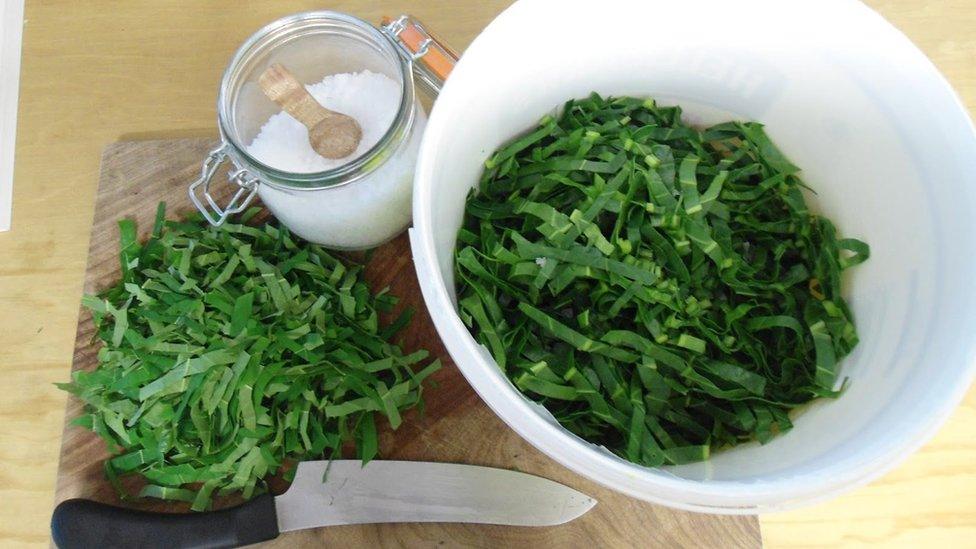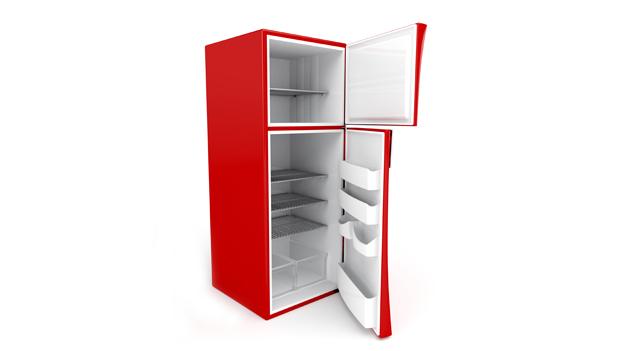Ketchup debate: To chill or not to chill...
- Published

Our fridges are stuffed with food that could also be kept in the cupboard. In the past, people kept butter, eggs and sauces in the pantry without getting ill. So why do many of us insist on keeping it all chilled?
A supermarket has begun stocking ketchup in the fridge, external section as well as on shelves in a bid to appease both camps.
Asda's poll of some 2,600 people found opinion was split, with 54% saying ketchup belonged in the cupboard and 46% saying they stored it in the fridge.
Some shoppers took to social media to say which part of the shop they would be heading towards.


But Polly Russell, a food historian from BBC Two's Back In Time For Dinner, said modern-day food chilling could be "bizarre".
Many brands we recognise today, such as Lea & Perrins Worcestershire Sauce, HP Sauce and Heinz Tomato Ketchup, were all sold before households had fridges, she explains.
"They were absolute life-savers for housekeepers - adding flavour to food that might be slightly bland or monotonous," Dr Russell said.
Their acidity levels, coupled with salt and sugar content, means they were - and still are - microbiologically safe to keep at room temperature.
"Households had no fridge, only cool boxes, or ice deliveries if it was a wealthy family."

The 1900s kitchen recreated in Further Back In Time For Dinner
In the latest series of Further Back In Time For Dinner, the Robshaw family are sent to a 1900s house - finding a kitchen with a cool-cupboard and overstuffed parlour instead of a fridge or freezer.
So when did this change?
As late as 1961, 20% of British households had a fridge, Dr Russell's research found. Yet half of these households probably owned a television.
It was only from 1968 that half of Britons owned a fridge.
Nearly 70 years on, we are fridge-obsessed.
Ms Russell said there was now an "increased anxiety" over food safety, meaning that we tend to chill foods when we do not need to.
"Shoppers don't trust the food they buy and hear mixed messages about what is and isn't safe," she said.

Only half of households had a fridge in the late '60s
But some people are attempting to resist our reliance on refrigeration.
"If we get more people into preserving food, we can reduce the need for a fridge," says Caroline Aitken, a food preservation teacher from Dartmoor.
Mrs Aitken, 38, teaches "permaculture", a movement that began in the 1970s and promotes self-sufficiency, growing food naturally and minimising waste.

Caroline Aitken says it is fine to leave cooked food in a cool room
"We've gradually lost our larders and now we've got very hot centrally heated houses," she said, adding that there was a "cultural fear" of leaving food out of the fridge.
She suggests pickling food from scratch using salt and water and keeping sugary preserves such as jam in the larder.
"Sauerkraut and kimchee are great to experiment with," she said. "I generally add three tablespoons of salt for every two kilos of shredded vegetables."

Mrs Aitken says people can go "over the top" with keeping food in the fridge, even once it has been cooked.
"You can have cold-store outside," she said. "If I've cooked a big stew I sit the pot in a room with a stone floor and it's perfectly fine to have the next day."
According to the government, the electricity costs of running a fridge bought in 2013 over a 12.5-year lifespan will total about £270, although it may be difficult to do without one altogether.
Even Mrs Aitken says she keeps some things, like her homemade yoghurt, in the fridge. "I just don't go over the top: tomatoes, citrus fruits, eggs, they shouldn't be in there."

Ketchup, eggs, butter and fruit: Is it bananas to keep them in the fridge?

Ketchup: It may have an altered taste or colour if kept in the cupboard, but the sauce's acidity means it will be safe to eat.
Tomatoes: Storing them at 5˚C can affect their flavour by reducing the activity of enzyme-producing genes, according to research.
Bananas: Will last longer in the fridge but should be left outside to ripen first.
Avocados: Also will not ripen properly if they're put in the fridge while still hard.
Eggs: Best stored in the fridge as they will be kept at a constant temperature, NHS advice states.
Leftovers: Cool them within two hours if possible and refrigerate, but eat within two days.
Bread: Can dry out and go stale more quickly in the fridge, but can be frozen.
Onions and potatoes: Best stored in a cool, dark cupboard.
Butter: Keep it in the fridge, especially if it is unsalted, but its fatty content means it can last at room temperature for a day or two.
Sources: NHS Food Safety advice, Proceedings of National Academy of Sciences journal

We would like to see what's inside your fridge, whether it's edible or not. Please send your pictures to yourpics, externalor tweet, external us.
- Published28 January 2015

- Published3 February 2017

- Published28 January 2015
